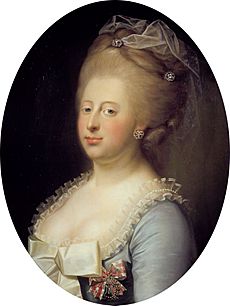Celle Castle facts for kids
Celle Castle, also known as Schloss Celle in German, is a beautiful old castle located in the town of Celle in Lower Saxony, Germany. It was once a home for the powerful Brunswick-Lüneburg family. This large, square-shaped castle is the biggest one in the southern part of the Lüneburg Heath area. It's a really important historical building!
Contents
The History of Celle Castle
Celle Castle started as a strong tower built to protect a crossing point over the River Aller. This first fort, called Kellu, was built around 980 AD by a count from the Brunonen family. Later, around 1292, Otto the Strict built another part, possibly extending the tower. You can still see parts of the old tower's basement today, under the castle theatre.
Around 1315, the castle was first officially recorded as Castrum Celle. In 1378, the Dukes of Brunswick-Lüneburg moved their main home, or Residenz, from Lüneburg to Celle. They began turning the old fort, which was surrounded by ditches and earth walls, into a grand castle.
Castle Changes Over Time
About a hundred years later, from 1471 to 1478, Frederick the Pious made the castle even bigger. The castle's chapel was blessed in 1485.
Ernest I the Confessor had the castle decorated in the beautiful Renaissance style starting in 1530. At the same time, between 1520 and 1560, the castle's defenses, like its walls and strong points called bastions, were moved further out. Back then, the castle was a typical square building with a courtyard, big corner towers, and a main tower. It showed off the special style of the Weser Renaissance.

From 1670 onwards, Duke George William made many changes to the castle. He wanted to turn the old Renaissance building into a modern home fit for a duke. George William loved building and made changes that reminded him of his time in Italy. The outside walls of the castle, which were inspired by buildings in Venice, got their look that you see today. Look for the crown of gables around the roofs and the unique shape of the domed towers. The castle theatre and the fancy Baroque rooms were also added during this time.

When Duke George William passed away in 1705, the rule of the dukes ended. The area around Lüneburg and Celle became part of the Kingdom of Hanover. The castle lost its political importance and was empty for a long time.
In 1772, a British-born Danish queen named Caroline Matilda moved into the castle. She was the daughter of Frederick Lewis, Prince of Wales. She had been sent to Celle after some trouble in Copenhagen. The queen lived at Celle Castle until 1775, when she sadly passed away from scarlet fever at a young age.
In the 1800s, the Hanoverian royal family sometimes used the castle as a summer home. Because of this, Georg Ludwig Friedrich Laves made some changes to the inside in 1839 and 1840. During World War I, the German Army used it as a camp for officers.
Celle Castle Today
The castle still has many different rooms and halls from various time periods. The court chapel was changed after the Protestant Reformation and still looks much like it did in the Renaissance. The fancy Baroque rooms, created under George William, are also still there.
In the Gothic Hall, you can find changing art shows. A part of Celle's Bomann Museum is in the East Wing, showing the history of the Kingdom of Hanover. You can visit the historic castle rooms and the chapel, which was restored between 1978 and 1981, by taking a guided tour.
Castle Theatre
The castle's theatre, called the Schlosstheater Celle, is one of the oldest preserved theatres of its kind. It's also one of the few Baroque theatres left in North Germany. It even has its own theatre company that performs there today!
How the Theatre Was Built
The current Schlosstheater was built because Duke George William wanted it. Before he became duke, he spent time in Venice and loved the Italian operas he saw there. The theatre was designed by an Italian architect named Giuseppe Arighini. Building work started in 1670 and was mostly finished by 1675. The duke often invited theatre groups from places like France, Italy, and Hanover to perform.
After the duke passed away, the theatre was not used much until Queen Caroline Matilda lived in the castle for a short time. A second balcony was added to the theatre for her.
The theatre was originally only for the people at the court. The public was not allowed to watch plays until the late 1700s. The theatre was used regularly until the late 1800s but closed in 1890. It was not used for a long time until it was fully renovated in 1935.
Castle Park
Celle Castle was never used for military purposes. So, between 1785 and 1802, the outer defensive walls were taken down. The dirt from these walls was used to fill in the deep, wide moats that once surrounded the castle.
In 1826, gardens were created around the castle by leveling the ground and removing the old defense mounds. Trees, bushes, and lawns were planted instead. In the 1800s, a beautiful landscape garden was made right around the castle. Some of the park was used for building homes around 1900, but the park still covers about 7 hectares (17 acres). The castle still sits on an island today, surrounded by water-filled moats.
Just outside the old defensive area, but not far from the castle, George William also had the French Garden built in the late 1600s. This was a Baroque park designed in the French style. Later, it was changed into an English landscape garden, but you can still see parts of the original French design in some areas of the park.



